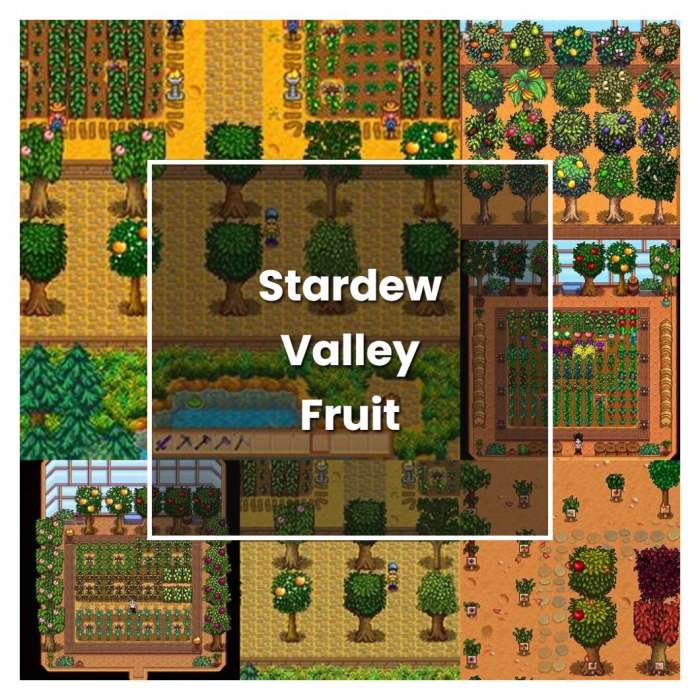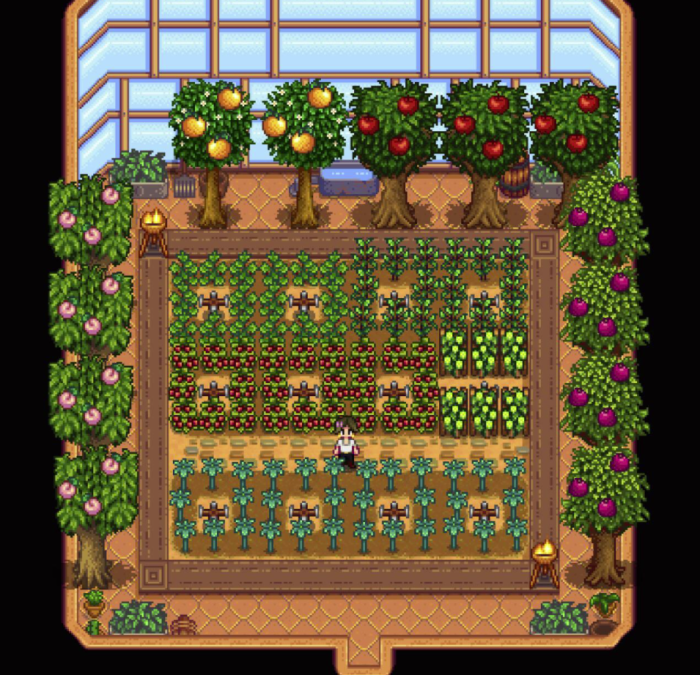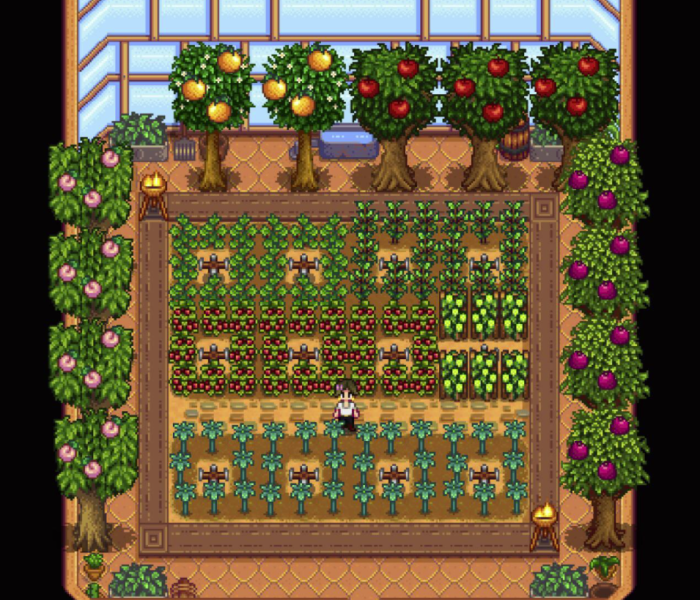Stardew Valley Plant Fruit Trees A Farmers Guide
Fruit Tree Selection in Stardew Valley

Stardew valley plant fruit trees – Choosing the right fruit trees in Stardew Valley is a crucial decision impacting your long-term farm profitability. Careful consideration of growth times, profit margins, and seasonal availability will significantly influence your farm’s success. This section will guide you through the process of selecting the most suitable fruit trees for your farming strategy.
Fruit Tree Growth Rates and Profitability
The following table compares the growth rates and profitability of various fruit trees, considering factors like harvest time and selling price. Remember that these values can be enhanced with the use of fertilizers and other farm upgrades.
| Name | Growth Time (Days) | Profit per Harvest (Gold) | Season |
|---|---|---|---|
| Apple | 28 | 100 (Base) | Fall |
| Cherry | 28 | 100 (Base) | Summer |
| Orange | 28 | 100 (Base) | Spring |
| Peach | 28 | 100 (Base) | Summer |
| Apricot | 28 | 100 (Base) | Spring |
| Pomegranate | 28 | 100 (Base) | Fall |
Note: Base profit assumes sale at the base price. Prices can increase with quality (Silver, Gold) and artisan goods.
Fertilizer Effects on Fruit Tree Growth and Yield, Stardew valley plant fruit trees
Utilizing fertilizers significantly impacts fruit tree growth and yield. Different fertilizers provide varying degrees of benefit. For instance, Deluxe Speed-Gro drastically reduces growth time, while Basic Fertilizer provides a modest boost. Using fertilizer on fruit trees leads to faster growth and larger harvests, increasing your overall profit. The return on investment for higher-grade fertilizers needs to be considered against the cost of the fertilizer itself.
This will depend on the value of the fruit harvested. A faster growing fruit tree that sells for a low price may not see as much profit increase from the fertilizer as a slower-growing, higher-value fruit.
Optimal Planting Seasons for Fruit Trees
Planting fruit trees during their appropriate season ensures optimal growth and timely harvests. Apples and pomegranates thrive in the Fall, while cherries and peaches flourish during the Summer. Apricots and oranges are best planted in the Spring. Planting outside of the optimal season will result in slower growth and potentially lower yields. Planning your orchard layout considering seasonal changes ensures a continuous flow of income throughout the year.
This allows for diversification of your farm’s output and maximizes the use of your land.
Optimizing Fruit Tree Placement and Layout: Stardew Valley Plant Fruit Trees
Effective orchard design in Stardew Valley, like in real-world agriculture, significantly impacts yield and overall farm efficiency. Careful consideration of sunlight exposure, space utilization, and ease of access are crucial for maximizing your fruit production. A well-planned orchard minimizes wasted space and effort, allowing for more efficient harvesting and resource management.
An efficient orchard layout prioritizes maximizing sunlight exposure while minimizing shading between trees. Imagine a design incorporating a staggered row pattern. Rows of trees are planted at a slight angle to each other, reducing the shadow cast by one tree onto another. This can be achieved with a spacing of approximately three tiles between each tree, allowing for ample growth and minimizing competition for sunlight.
Pathways, two tiles wide, are integrated between the rows, providing easy access for harvesting and maintenance. An efficient irrigation system, perhaps using sprinklers or a carefully planned series of watering cans, is crucial. This system should cover the entire orchard effectively, ensuring consistent moisture levels for optimal fruit growth. The specific arrangement will depend on the size and shape of your orchard area.
Right, so you’re into Stardew Valley and fancy planting some fruit trees, yeah? Getting those orchards looking lush is a proper vibe. If you’re after some serious horticultural inspo, check out this cracking list of most beautiful trees to plant – it’ll give you ideas for your next Stardew Valley farming mega-project. Then you can totally nail that perfect orchard aesthetic, innit?
A larger orchard might benefit from a more complex layout with multiple sections, each with its own access pathway and irrigation strategy.
Space Optimization in Smaller Farms
Managing space constraints requires creative orchard designs. For smaller farms, consider vertical space. Utilizing trellis systems allows you to plant fruit trees in a smaller footprint, while still yielding a significant amount of fruit. Think of a compact design with trees planted closely together, trained to grow upwards along a vertical support structure. This arrangement maximizes yield in a limited space.
Another approach is to use a square planting method, arranging trees in a grid pattern. This approach is efficient if you are working with a square or rectangular space, but can be less effective in irregularly shaped areas. While this limits the number of trees compared to a row-planting method, the close spacing minimizes wasted space and allows for more efficient harvesting.
Careful consideration of tree growth patterns is important to avoid overcrowding.
Comparison of Square and Row Planting Methods
Square planting, as mentioned, arranges trees in a grid pattern, maximizing space utilization in a square or rectangular area. This method facilitates easy access to each tree for maintenance and harvesting. However, it can lead to increased competition for resources, especially sunlight and water, if the trees are planted too close together. Row planting, on the other hand, involves planting trees in straight lines, typically with spacing between rows to allow for easier access and irrigation.
This method can be less efficient in terms of space utilization, particularly in smaller areas, but can allow for better sunlight penetration and potentially higher yields if spacing is optimized. The best method depends on the available space, the specific fruit tree type, and the farmer’s preferences and resources. Careful planning and observation are key to success with either method.
Integrating Fruit Trees into Farm Design

Integrating fruit trees effectively into your Stardew Valley farm requires careful planning, considering both aesthetic appeal and practical yield. Strategic placement maximizes sunlight exposure, minimizes shading of other crops, and optimizes your workflow. This holistic approach ensures a thriving and visually pleasing farm, mirroring the careful consideration we give to our own lives and environments in real-world planning.A sample farm layout might feature a central orchard of apple, cherry, and peach trees, positioned to receive maximum sunlight.
This orchard could be bordered by a perimeter of berry bushes, providing a natural visual transition and a readily accessible source of early-game income. To the north, perhaps shielded from harsh winds by the orchard, you could have a dedicated area for crops like potatoes and cauliflower, requiring less sunlight. Farm buildings, such as the barn and coop, could be strategically placed to minimize obstruction and maximize accessibility.
The farmhouse itself might be nestled amongst a carefully curated garden, integrating both function and beauty. This layout allows for efficient harvesting and movement while providing a visually stunning and diverse farm landscape.
Fruit Tree Impact on Farm Aesthetics and Design
The visual impact of fruit trees is significant. Their height and varying blossom colors (depending on the season and tree type) create depth and interest in the farm’s landscape. The contrast between the trees’ verticality and the horizontal lines of tilled fields enhances the overall aesthetic appeal. Strategically placed fruit trees can act as natural dividers, creating distinct zones within the farm.
Imagine a line of plum trees separating your main crop fields from a dedicated area for artisan goods production, such as wine or preserves. The carefully planned integration of fruit trees contributes to a sense of balance and harmony, creating a visually pleasing and relaxing environment.
Fruit Tree Role in Attracting Beneficial Insects and Improving Biodiversity
Fruit trees, especially those with diverse varieties, support a wider range of beneficial insects. These insects can help control pests, promoting a healthy and balanced ecosystem within the farm. For instance, ladybugs, often attracted to flowering fruit trees, are effective predators of aphids, a common pest for many crops. The flowers themselves attract pollinators such as bees, which in turn benefit the overall yield of your farm.
By introducing diverse plant life, including fruit trees, you create a more resilient and robust ecosystem, minimizing reliance on pesticides and promoting a healthier, more natural farming approach. This parallels the way diverse social interactions and support networks contribute to a healthier and more resilient individual life.
Questions Often Asked
What’s the best fertilizer for fruit trees?
Deluxe Speed-Gro is the ultimate power-up for fast growth, but regular Speed-Gro is a good budget option. For a more sustainable approach, try using basic fertilizer.
Can I plant fruit trees in the winter?
Nope, you can only plant fruit trees during Spring.
How do I get more fruit tree saplings?
You can buy them from Pierre’s shop, find them in chests, or grow them from seeds you get from foraging or shaking trees.
What’s the deal with different quality fruits?
Higher quality fruits (Silver, Gold) produce better saplings when you replant them, leading to faster growth and better yields down the line.

